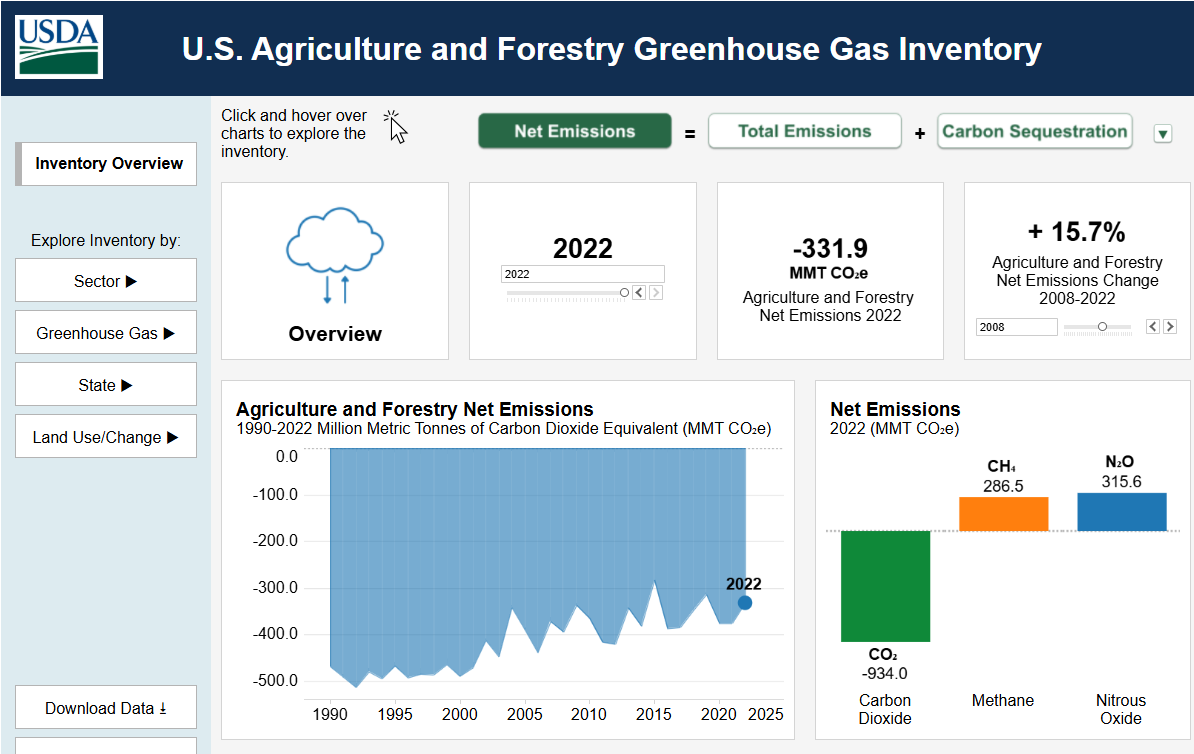Greenhouse Gas Inventory and Assessment Program

Overview
USDA’s Greenhouse Gas Inventory and Assessment Program, managed by the Office of the Chief Economist, maintains state-of-the-science metrics of greenhouse gas sources and sinks from lands and links these metrics to Department-wide efforts to mitigate climate change.
The Program works closely with agencies across USDA and other Federal agencies to improve data collection. These data are used to monitor and track trends in carbon sequestration and emissions through the Program, ensuring that the most up-to-date climate-smart agriculture and forestry practices are included in greenhouse gas estimates.
The Program provides timely reports and analyses to establish methodologies and support decision-making, including analyzing and forecasting greenhouse gas emissions from the agriculture, forestry, and land sectors and assessing the mitigation potential of actions.
USDA supports a variety of efforts and tools to quantify GHG emissions from agriculture and forestry, and the potential for GHG mitigation through conservation practices and carbon sequestration. USDA regularly releases an inventory of agriculture and forestry emissions while lending support to the EPA’s annual GHG inventory.
Featured
NEW -- Agriculture and Forestry Greenhouse Gas Inventory Data Viewer: The Agriculture and Forestry Greenhouse Gas Inventory Data Viewer is an interactive tool where users can view and engage with the latest agriculture and forestry data from EPA's Inventory of U.S. Greenhouse Gas Emissions and Sinks. All Inventory data are available for download.
Resources and Reports
U.S. Agriculture and Forestry Greenhouse Gas Inventory (PDF, 17.6 MB)
USDA’s greenhouse gas inventory (this edition published in 2022) contains information on GHG emissions and sinks in agriculture and forestry for the years 1990 to 2018 at the state and regional scales.
Previous USDA Inventories:
1990-2018 USDA Greenhouse Gas Inventory (PDF, 17.6 MB)
1990-2013 USDA Greenhouse Gas Inventory
1990-2008 USDA Greenhouse Gas Inventory
1990-2005 USDA Greenhouse Gas Inventory
1990-2001 USDA Greenhouse Gas Inventory
Inflation Reduction Act and MMRV work
USDA is investing $300 million to improve USDA’s Measuring, Monitoring, Reporting and Verification (MMRV) efforts. OCE, ARS, ERS, NASS, and NRCS will collaborate to advance seven MMRV workstreams. The data collected will improve metrics for Natural Resources Conservation Service (NRCS) programs, strengthen models and tools, and support the Greenhouse Gas Inventory and Assessment program.
Additional Resources:
IRA Quantification Webinar Series
Press Release for Webinars
This report outlines a draft framework for measurement, monitoring, reporting, and verification of greenhouse gas (GHG) emissions and removals for the agriculture and forest sectors, as part of a larger Federal strategy to advance an integrated U.S. GHG monitoring & information system. USDA has issued a request for public comment on behalf of the Administration. View the request for comment.
This work provides estimates of the costs of greenhouse gas (GHG) mitigation that would occur on working U.S. farms and ranches for specific suites of technologies and practices. Understanding the costs and greenhouse gas benefits is important in helping U.S. farmers create new and expand existing market opportunities for agricultural commodities produced with “climate-smart” farming practices. This report provides a valuable update to past studies our office commissioned in 2013 and 2016. First, it expands the set of practices to include biochar amendments, alternate wetting-and-drying during rice production, cover crops, feed management strategies, enhanced efficiency fertilizers, and prescribed grazing. Second, it updates cost and greenhouse gas reduction estimates for several practices included in past studies, like conservation tillage and manure management, based on more recent data.
This ICF report from 2016 presents an analysis of the GHG mitigation potential associated with changes in U.S. agricultural management practices as well as Marginal Abatement Cost Curves for each practice.
This report from 2016 outlines projections for agriculture, forestry, and land use emissions for 2015 to 2060.
This inter-agency report from 2015 details planning improvements in GHG inventories, emissions projections, and mitigation activities in the land sector.
The purpose of this 2013 report is to identify and describe specific technologies and practices that farmers could adopt in their crop and livestock production systems and in their land management decisions that would result in net greenhouse gas mitigation.
Tools and Methods
- COMET-Farm
COMET-Farm is an interactive online tool to estimate whole-farm, ranch, and forestry emissions and mitigation options. - COMET-Planner
COMET-Planner is an interactive evaluation tool designed to evaluate potential carbon sequestration and greenhouse gas reductions from adopting NRCS conservation practices. - COMET-Energy
COMET-Energy is a stand-alone tool that allows users to calculate reductions in greenhouse gas emissions based on anticipated fuel savings. - Forest Management for Carbon Benefits
This module of the Climate Change Resource Center provides resources, including topic overviews, tools, videos and short-courses, on carbon management in forests and grasslands.



